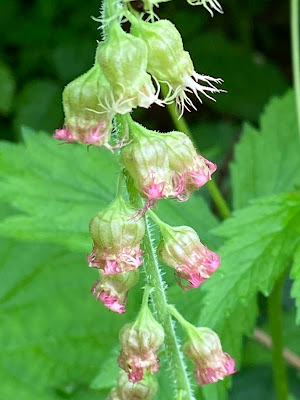Trail signs
The most recent hike we did was Chiwaukum Creek, Wenatchee National Forest in eastern Washington. It takes about 2 hours to drive from the city to the trail head. Since folks always ask, yes, there is an outhouse at the trail head. It was sunny and already getting warm when we parked. A Forest Service Pass is required, such as the Northwest Forest Pass, or for retirees there is a one time only fee for a Senior Pass called the America the Beautiful National Parks and Federal Lands Pass.
The trail follows along Chiwaukum Creek for part of the way
Some of the burned trees have been topped leaving tall snags or stumps
Other burned trees will eventually weather to a white color and become "ghost trees"
This area is renowned for its wildflowers including some that only grow there. This is peak bloom time and we hoped to find some favorites. There was a fire in 2014 that destroyed hundreds of trees. The last time we hiked here was before the fire and we were not sure what the forest would look like or if much of the low growing plants had survived and been able to grow back. Also, the day continued to get warmer as we progressed along the way. Eastern Washington gets more sun and can be considerably hotter than the western side of the mountains making shade a coveted commodity.
Because there were not many trees left to provide any shade, we were not able to hike as far as we had hoped. Our original goal was a 5-mile round trip with a 500 ft elevation gain. It did not appear that many people had been hiking on this trail since the fire. We met only one other person, a young man backpacker, who was returning from a 3-day camping trip. He gave us a report on snakes (he put on gators after finding a baby rattlesnake), bears (he encountered one at a safe distance and set up a motion sensor in his tent just in case it got too close), he also saw deer and elk. He mentioned that the conditions of the trail and forest ahead were a bit worse. There was a downed tree about one or two miles ahead of where we met him and he advised turning around if we made it that far. He had had difficulty climbing over the tree, couldn’t see a way around it, and thought it would probably be a bit risky for us to try. As it turned out, we did not get that far. The temperature had climbed to almost 80 degrees F in the bright sun and both of us were feeling the heat. In the end we went 3 ½ miles RT, which felt like a lot longer, with a 350 ft elevation gain.
While not many of the trees had any life left from the fire, the undergrowth was coming back and many of the flowers we hoped to find we found. Both of us remembered finding Tweedy's Lewisia flowers at the first switchback from our previous hike before the fire, but they were not there this time. We later found several patches of it further along the trail. In all we counted over 30 different kinds of flowers.
Yellow Salisfy
Heartleaf Balsamroot
Mertensia
Indian Paintbrush
Lupine
Penstemon
Rockslide Larkspur
Serviceberry aka Saskatoon
Snowbrush
Wild chickweed sometimes called Prairie flower
Vine maple flower
Have you ever wondered what a maple bat flower looks like? This is it. Very tiny and delicate.


















































